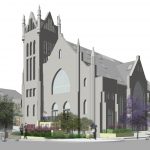Measuring Mayor Norquist
By Raymond Johnson
As the final term of Milwaukee Mayor Norquist comes to a close, it is time to assess his impact on the city. I’ll leave it to others more qualified to weigh his affect on property taxes or schools, on government efficiency or city services. Here, per the name, I will be concerned about the developing city.
Perhaps nothing indicates the Mayor’s interest in these matters more than the next job he is taking. John O. Norquist will become the President and CEO of the Congress for the New Urbanism (CNU), a national advocacy organization dedicated to promoting good urban design. Mr. Norquist had served on the board of directors, and has shown supporters and skeptics alike the possibilities for using the principles of the CNU in existing cities.
Perhaps the best way to understand the impact of his work is to look at some of the projects built on Mr. Norquist’s watch and assess their overall impact on the city.
THE GOOD
This has to be the apotheosis of Mr. Norquist’s tenure, bringing together key elements in his thesis on good urban design: freeways are bad for center cities because street grids are better movers of traffic; center cities are desirable because of their efficient access to people and markets; and government doesn’t need to subsidize private development. Sure, it will be a long time before it is ‘finished’, and we will probably get more than a few bad buildings, but if you love cities, this is about as good as it gets.
The Riverwalk
The Riverwalk is a close second to the Park East project. This is urbanism at its finest. Small-scale, pedestrian-oriented, and snaking through our city, the Riverwalk gives urban dwellers and visitors a different path through the city. Granted, its’ design, in places, is a bit pedestrian itself. The materials are sometimes cheap, the style retrograde, the details sloppy, and it often connects poorly with both the water and the city streets. But early mistakes lead to ongoing improvement. And really, the chief benefits of the Riverwalk are the improvements to our overall urban structure downtown: increased pedestrianism, new residences, shops and restaurants, and the reconnection of the city to its river.
Third Ward Redevelopment
The redevelopment of the Third Ward has been nothing short of amazing. Once an area of abandoned and underused storage buildings, the Third Ward is booming with loft conversions, new construction and restaurant and boutique openings. The overall street-scaping is of a decent muscular industrial style, in tune with the manufacturing history of the area. An amazing opportunity was missed when the area nixed a beautiful modern parking garage designed by Gastrau Furer Vogel Architects for the piece of junk you see standing on the corner of Water and Erie. This raises the question: as new construction pressures build, will the Third Ward build beautiful modern buildings to complement its beautiful existing ones? Time will tell.
6th Street Viaduct
Until a few years ago, Mr. Norquist was accused of fearing modern architecture. In some respects he did, and often with good reason. This project changed all that. Built in an iconographic modern style similar to the Calatrava, it shows the possibilities for making infrastructure architectural. It also works well from the standpoint of usability. Though it was built by the auto-oriented Wisconsin DOT, it includes wide sidewalks and bike lanes, at the Mayor’s insistence. And by making a more direct connection to the Menomonee Valley, the new viaduct should speed up valley redevelopment.
The Milwaukee Art Museum Addition
This is the crown jewel of Milwaukee modern architecture, whose history is admittedly suspect overall. But it is, for the most part, a gem. Sure Santiago Calatrava is a better engineer than architect, a better designer of infrastructure than of buildings. His bridges are amazing, as are his transport centers. This isn’t a great building for displaying art (why are those skylights in the main gallery still covered?), and it has all but bankrupted our philanthropic community, but the Calatrava is a great building for the city of Milwaukee.
THE BAD
Miller Park
Mr. Norquist did about the best he could with this one. He knew it should have been downtown, so that the team wouldn’t always have to be the draw, and the restaurants and the ability to walk to a game after work could shore up attendance during lean years. He even hired a respected Chicago architect and baseball lover, Philip Bess, of Thursday Architects, to help him make the case. Unfortunately for everyone, Bud Selig couldn’t be convinced, and now we are stuck with a bad ballpark. And with the recent player payroll cuts, and the ouster of Ulice Payne, Mr. Norquist is looking more and more right. The roof is a nice bit of engineering, but also completely unnecessary.
Just as Milwaukee was beginning to understand the negative consequences of freeways in urban areas, the WDOT got this freeway built all the way down to Layton Ave. They did so in part by calling it a parkway, giving the impression it would be beautiful. It isn’t. It is ugly, using that same ugly red stamped asphalt now popping up everywhere (five points and Capitol Dr. are two examples). And it is slow. The speed limit is only 40 mph, even though the design makes you want to go at least 50. The only real benefit is the view it offers of Mitchell Field at its terminus, and the ability to enter the airport via city streets. Maybe if everyone boycotts it and uses Kinnickinnic Ave. instead, we can tear this ‘parkway’ down in a couple of decades.
THE UGLY
The New Convention Center
Back when Mr. Norquist was still deriding modern architecture, he used to call the old convention center, then known as the Mecca, the world’s largest VCR. At least it had no pretensions: it was what it was — a big dumb box. The new convention center is also a big dumb box, but with a lot of turrets, arches, and finials to make you forget it’s a big dumb box. Why couldn’t Milwaukee have just made a beautiful big dumb box? Oh well, there’s always next time, which is in about 25 years, according to my calculations.
Space prohibits assessment of the new Milwaukee Technical High School, the rebuilt Lincoln Memorial Drive, the numerous street-scaping projects, the reemergence of the harp light, or the forthcoming Third Ward Public Market. And there are lots of smaller projects with just as much influence on their neighborhoods.
Perhaps the best thing Mayor John O. Norquist has done for the developing city is to use his bully pulpit. He has asked us to look anew at cities like Milwaukee. He has told us to stop pitying them, to see them as the economic and cultural centers they are. He has shown us that cities matter, and that they matter in ways we are only beginning to rediscover. As Mr. Norquist departs, we are left to wonder who will carry that banner, or whether it will be carried at all.




















